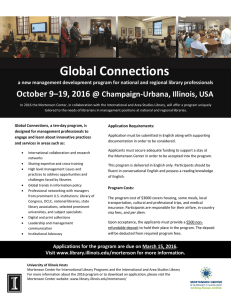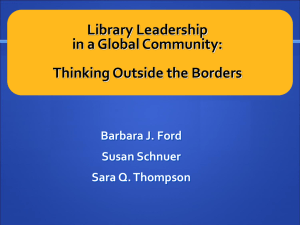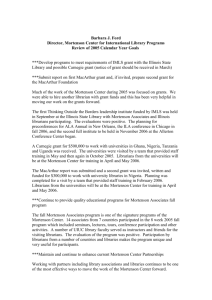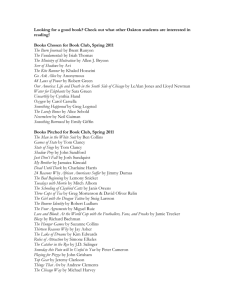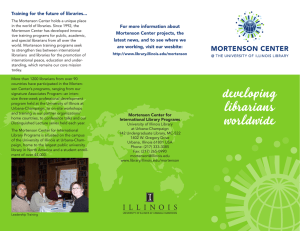Before conducting an evaluation of the Mortenson
advertisement
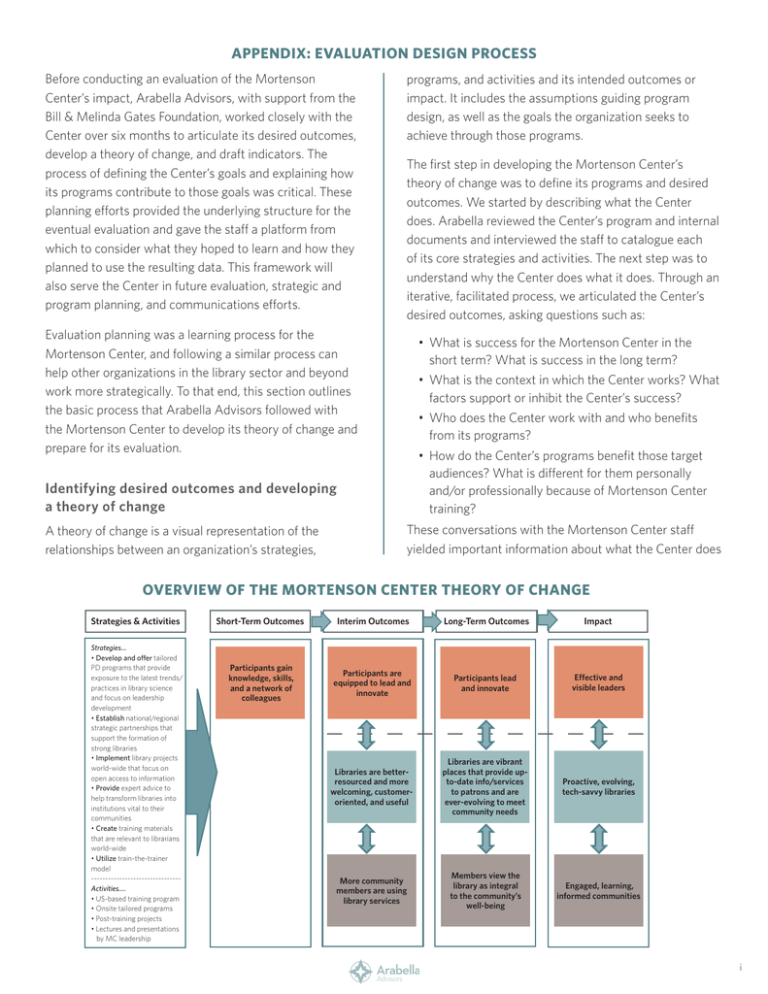
APPENDIX: EVALUATION DESIGN PROCESS Before conducting an evaluation of the Mortenson Center’s impact, Arabella Advisors, with support from the Bill & Melinda Gates Foundation, worked closely with the Center over six months to articulate its desired outcomes, develop a theory of change, and draft indicators. The process of defining the Center’s goals and explaining how its programs contribute to those goals was critical. These planning efforts provided the underlying structure for the eventual evaluation and gave the staff a platform from which to consider what they hoped to learn and how they planned to use the resulting data. This framework will also serve the Center in future evaluation, strategic and program planning, and communications efforts. programs, and activities and its intended outcomes or impact. It includes the assumptions guiding program design, as well as the goals the organization seeks to achieve through those programs. The first step in developing the Mortenson Center’s theory of change was to define its programs and desired outcomes. We started by describing what the Center does. Arabella reviewed the Center’s program and internal documents and interviewed the staff to catalogue each of its core strategies and activities. The next step was to understand why the Center does what it does. Through an iterative, facilitated process, we articulated the Center’s desired outcomes, asking questions such as: Evaluation planning was a learning process for the Mortenson Center, and following a similar process can help other organizations in the library sector and beyond work more strategically. To that end, this section outlines the basic process that Arabella Advisors followed with the Mortenson Center to develop its theory of change and prepare for its evaluation. • What is success for the Mortenson Center in the short term? What is success in the long term? • What is the context in which the Center works? What factors support or inhibit the Center’s success? • Who does the Center work with and who benefits from its programs? • How do the Center’s programs benefit those target audiences? What is different for them personally and/or professionally because of Mortenson Center training? Identifying desired outcomes and developing a theory of change A theory of change is a visual representation of the relationships between an organization’s strategies, These conversations with the Mortenson Center staff yielded important information about what the Center does OVERVIEW OF THE MORTENSON CENTER THEORY OF CHANGE Strategies & Activities Strategies… • Develop and offer tailored PD programs that provide exposure to the latest trends/ practices in library science and focus on leadership development • Establish national/regional strategic partnerships that support the formation of strong libraries • Implement library projects world-wide that focus on open access to information • Provide expert advice to help transform libraries into institutions vital to their communities • Create training materials that are relevant to librarians world-wide • Utilize train-the-trainer model -------------------------------Activities…. • US-based training program • Onsite tailored programs • Post-training projects • Lectures and presentations by MC leadership Short-Term Outcomes Interim Outcomes Long-Term Outcomes Impact Participants gain knowledge, skills, and a network of colleagues Participants are equipped to lead and innovate Participants lead and innovate Effective and visible leaders Libraries are betterresourced and more welcoming, customeroriented, and useful Libraries are vibrant places that provide upto-date info/services to patrons and are ever-evolving to meet community needs Proactive, evolving, tech-savvy libraries More community members are using library services Members view the library as integral to the community’s well-being Engaged, learning, informed communities i and what it seeks to achieve, which we used to inform draft desired outcomes. We then conducted interviews with a small set of previous training participants to understand in greater detail how they viewed the Center’s programs and how those programs affected their work. With this information, we updated the draft desired outcomes, which we shared with Mortenson Center staff and revised iteratively. After finalizing the desired outcomes, we depicted their inter-relationship in the theory of change. In addition to showing how programs lead to outcomes, the theory of change shows how short-term outcomes feed into interim and long-term outcomes and impact. Using arrows, it shows that outcomes at the librarian, library, and community levels are interrelated and mutually reinforcing. Finally, the theory of change includes a dotted line, indicating that the Mortenson Center has direct influence on librarian outcomes and indirect influence on library and community outcomes. Designing a retrospective evaluation plan After developing the theory of change, Arabella worked with the Mortenson Center and the Bill & Melinda Gates Foundation to understand what they hoped to learn from a retrospective evaluation. Arabella asked questions such as: • What do you already know about the Mortenson Center’s impact? How do you know this? • How do you use data in your work now, and how would you like to be able to use data in the future? • How do you communicate about your impact now, and how would you like to be able to communicate about it in the future? The Mortenson Center wanted a broad, data-driven understanding of its impact to supplement anecdotal examples. It wanted this information both to inform its programs and to share with stakeholders, such as funders, partners, and participants. Based on these conversations, we developed a qualitative and quantitative evaluation methodology featuring participant interviews and surveys that sought to address three key evaluation objectives: 1. Assess the extent to which the Center has achieved the outcomes it seeks regarding librarians, libraries, and communities, and how it has achieved them. 2. Determine which aspects of the Mortenson Center’s program implementation contribute most to creating the outcomes and impact these programs yield. 3. Determine what data the Mortenson Center should collect and what practices it should put in place to implement ongoing strategic learning and evaluation. Before collecting evaluation data, we developed indicators as a bridge between evaluation planning and evaluation implementation. Indicators are specific measures against which an organization can track its progress toward a goal. For example, one of the Center’s desired outcomes is that its participants take on leadership roles in their local library sector. The indicator to measure progress against this outcome is the percent of librarians that have taken on leadership roles in library professional networks. From there, we developed a survey question asking whether participants have taken on new leadership roles in these networks and a series of interview questions to understand the roles they have taken and the factors contributing to their gaining these roles. With the indicators in place, the evaluation proceeded with data collection—including interviews and surveys, data analysis, and development of an evaluation report with key findings and recommendations. Implementing an ongoing evaluation approach Now that Arabella Advisors and the Mortenson Center have completed the retrospective evaluation, the Center is interested in deepening its own ability to monitor, evaluate, and learn from its work over time. Arabella is working closely with the Center to develop tools—such as a measurement plan, which maps its desired outcomes and indicators to relevant data collection tools—and to provide training that helps the Mortenson Center build on what it has learned through the retrospective evaluation and integrate data more into its planning and decisionmaking processes. ii
